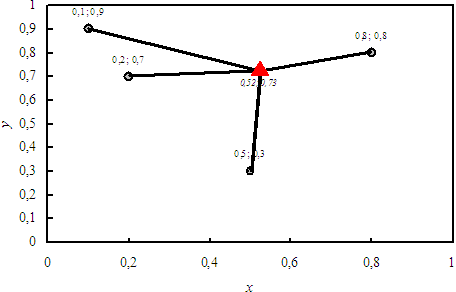Finds the optimal location,
with coordinates X, Y, of a facility, P
(red triangle in the Figure), for a source
so as to minimize z, total cost of transportation
to all the given destinations
(4 points in the Figure), these requiring given quantities of goods,
the capacities, Q, at given unit costs,
C. (Direction of flow is immaterial.)
The coordinates of P (X and Y)
are assumed continuous. (An alternate, discrete strategy would be
to give a set of candidate locations to optimize from.)
Point P is found by a minimization method.
A graph of the source coordinates and minimum cost
—X, Y and z*—
is made versus Q1 varying from 0 % to 100 %
(of ∑iQi).
For a regular polygon, remark that the final result must obviously be
(X, Y) = (1, 0) and z = 0. |
 |
¹ For n < 0,
the destinations are the |n| vertices of a generated
regular polygon (RP) inscribed in a unit circle, with first point
(+1, 0), and costs made unity.
² Although ignored, the correct number of (any) values
must be supplied !
³ The "circuity factor"
is the quotient 'real distance' ⁄ 'straight line distance'
(suggested value). |
|
|
• Buescu, J., 2009, O mistério do armazém absorvido.Pdf*,
Ingenium (in Portuguese,
"The mystery of the absorbed warehouse").
• Hutt, Michael F.,
Programming,
Nelder-Mead Simplex Fortran 90.
• Dennis, Jr., J. E., and
Robert B. Schnabel, 1996,
"Numerical methods for unconstrained optimization and nonlinear equations",
SIAM, Philadelphia, PA (USA).
. ISBN 0-89871-364-1 (pp 168–174.pdf).
• Burden, Richard L. and
J. Douglas Faires, 1997, 6.th. (2004, 8.th) ed.,
"Numerical analysis", Brooks/Cole Publishing Company, Pacific Grove, CA (USA).
ISBN 0-534-95532-0 (pp 607 ff.).
• Biegler, L. T. (research group):
nonlinear
equations.pdf
(=)
AdvProcSysEng.ing
(Carnegie Mellon Univ.).
• Ortega,
J. M. and W. C. Rheinboldt, 1970,
"Iterative solutions of nonlinear equations in several solutions",
Academic Press, London (UK). ISBN 0-12-528550-7 (pp 189–200: secant methods.pdf).
• Walton,
Andrew G.: Solution
of nonlinear algebraic equations.pdf
(=),
Imperial College London.
• Mathews,
John H., 1987,
"Numerical methods for computer science, engineering, and mathematics",
Prentice-Hall, Inc., Englewood Cliffs, NJ (USA).
ISBN 0-13-626656-8. Broyden's method.
*"Pdf" means a scanned
(image) 'pdf'.
• 1867-11-03: Kutta, Martin Wilhelm
(† 1944-12-25, 77 yrs.). |



